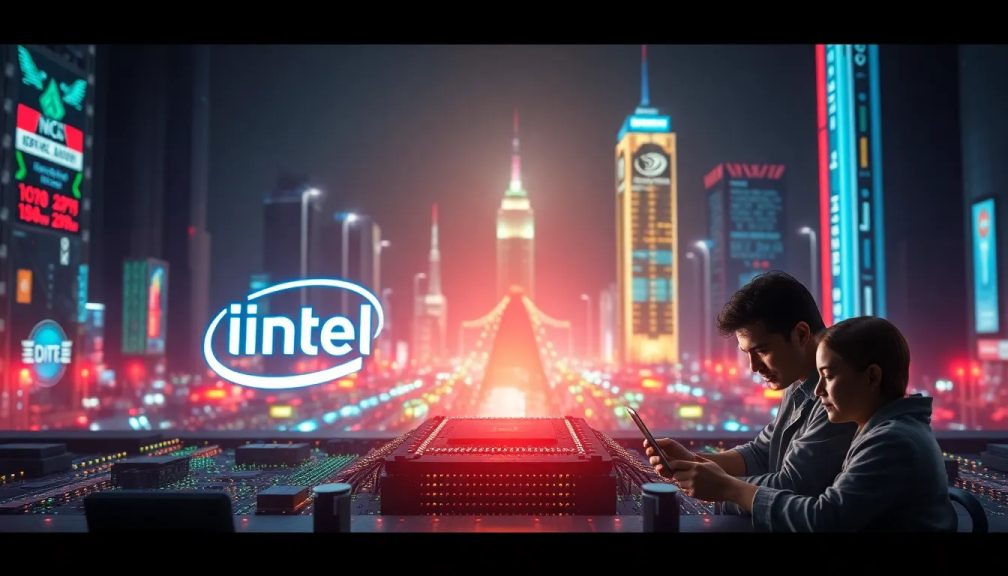Intel and Nvidia remain committed to ARC and ARM technologies

The recent alliance between Intel and Nvidia has sent ripples through the tech community, sparking discussions about the future of their respective product lines and the competitive landscape of the semiconductor industry. With both companies holding significant stakes in the market, this partnership raises questions about innovation, competition, and the direction of their product development. As we dive into this topic, it’s essential to unpack what this means for both giants and the broader implications for the tech sector.
- Will Intel's Arc GPU Compete Effectively with Nvidia?
- Why is Intel Not Performing as Strongly as Nvidia?
- How Will the New Intel-Nvidia Partnership Influence Product Development?
- Is Intel Still Committed to Developing ARC?
- The Future of ARM Technology in Nvidia's Strategy
- Conclusion: The Road Ahead for Intel and Nvidia
Will Intel's Arc GPU Compete Effectively with Nvidia?
The Intel Arc series was designed to carve out a niche in the discrete graphics market, aiming to provide competitive performance against established players like Nvidia and AMD. However, the question remains: can Intel's Arc line hold its ground against Nvidia's dominance?
Intel's approach focuses on delivering a range of GPUs tailored for different segments, from casual gamers to high-end graphics applications. Yet, the performance metrics and driver stability of the Arc GPUs have been under scrutiny since their launch. Users have reported various issues, including:
- Driver bugs and instability.
- Limited support for certain gaming titles.
- Performance inconsistencies compared to Nvidia's RTX series.
In terms of features, Intel has promised robust support for ray tracing and AI-driven enhancements, but execution has varied. As the competition heats up, Intel needs to focus on not just hardware performance but also on software optimization to ensure a seamless gaming experience.
Why is Intel Not Performing as Strongly as Nvidia?
Several factors contribute to Intel's struggle to gain traction in the GPU market compared to Nvidia, which has established itself as a leader with its GeForce line. Some of these factors include:
- Legacy Issues: Intel's historical focus has primarily been on CPUs, making its transition into GPUs challenging.
- Market Perception: Nvidia is perceived as the go-to brand for gaming GPUs, making it difficult for Intel to change consumer sentiment.
- Software Ecosystem: Nvidia has a robust software suite that enhances performance and user experience, which Intel has yet to fully develop.
Additionally, Nvidia's partnerships and software innovations, such as DLSS (Deep Learning Super Sampling), have positioned it favorably among gamers and developers alike. Without a strong software offering, Intel's hardware advancements may not be enough to sway users.
How Will the New Intel-Nvidia Partnership Influence Product Development?
The partnership between Intel and Nvidia represents a significant shift in strategy for both companies. While the full implications are yet to be seen, initial reports suggest that the focus will be on integrating x86 architecture with Nvidia’s GPU technology. This could lead to the development of highly efficient system-on-chip (SoC) solutions, designed for both PCs and other platforms.
According to Nvidia CEO Jensen Huang, the first product emerging from this collaboration will be a “GB10” chip, featuring:
- x86 CPU cores.
- Nvidia GPU via NVLink.
- Enhanced performance for applications needing high graphics fidelity.
This collaboration is particularly interesting as it hints at the potential for a new class of computing devices that leverage the strengths of both companies. However, it leaves open questions about how this will affect existing product lines, especially Intel's ARC series, which the company insists will remain a part of their roadmap.
Is Intel Still Committed to Developing ARC?
Despite the new partnership with Nvidia, Intel has reiterated its commitment to the Arc GPU lineup. The company has stated that the collaboration will complement its existing roadmap rather than derail it. This commitment indicates that Intel still sees potential in the Arc series, even as they explore synergies with Nvidia's technology.
Intel's focus on enhancing the Arc lineup is critical, especially as the competition intensifies. Developments in driver performance, feature sets, and integration with gaming ecosystems will be vital areas of focus going forward. The company is likely to pursue the following strategies:
- Improving driver stability and performance.
- Expanding compatibility with popular gaming titles.
- Enhancing features to compete with Nvidia's offerings.
As these developments unfold, industry observers will be keen to see how Intel manages to balance its internal ambitions with the collaborative efforts of this partnership.
The Future of ARM Technology in Nvidia's Strategy
Another aspect of the Intel-Nvidia partnership touches on Nvidia's ongoing commitment to ARM technology. Despite the focus on x86 architectures for their new products, Nvidia has affirmed that ARM will continue to play a crucial role in their future developments, particularly for:
- Server solutions.
- Automotive applications.
- AI and machine learning devices.
This dual approach—integrating both x86 and ARM technologies—allows Nvidia to cater to a broader range of markets while capitalizing on the strengths of each architecture. However, it raises questions about the strategic direction of their product portfolio and how they will manage the complexities that come with supporting multiple architectures.
Conclusion: The Road Ahead for Intel and Nvidia
The partnership between Intel and Nvidia is set to reshape the landscape of the tech industry, with significant implications for product development and market competition. As both companies navigate this collaboration, they must address the challenges posed by their existing product lines while innovating to meet the demands of consumers and enterprises alike.
The tech community eagerly anticipates what the future holds, particularly in terms of performance improvements, new product offerings, and the broader impact on the semiconductor market.
For those interested in a deeper dive into the implications of this partnership and the technology behind it, you can watch the following video to gain more insights:




Leave a Reply